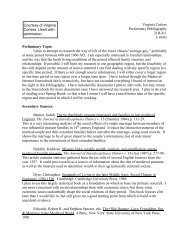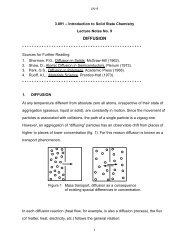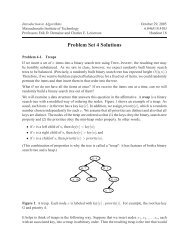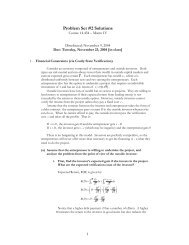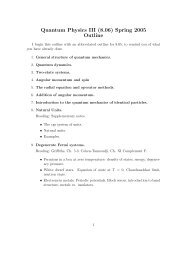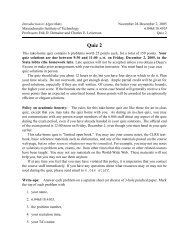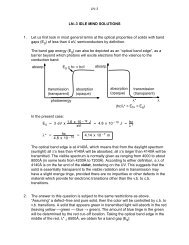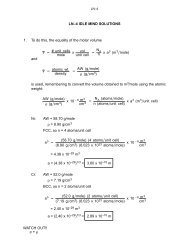Problem Set 6
Problem Set 6
Problem Set 6
You also want an ePaper? Increase the reach of your titles
YUMPU automatically turns print PDFs into web optimized ePapers that Google loves.
Introduction to Algorithms October 31, 2005Massachusetts Institute of Technology6.046J/18.410JProfessors Erik D. Demaine and Charles E. Leiserson Handout 19<strong>Problem</strong> <strong>Set</strong> 6MIT students: This problem set is due in lecture on Monday, November 7, 2005. The homeworklab for this problem set will be held 2–4 P.M. on Sunday, November 6, 2005.Reading: Chapter 17 and the handout on competitive analysis.Both exercises and problems should be solved, but only the problems should be turned in.Exercises are intended to help you master the course material. Even though you should not turn inthe exercise solutions, you are responsible for material covered in the exercises.Mark the top of each sheet with your name, the course number, the problem number, yourrecitation section, the date and the names of any students with whom you collaborated. Pleasestaple and turn in your solutions on 3-hole punched paper.You will often be called upon to “give an algorithm” to solve a certain problem. Your write-upshould take the form of a short essay. A topic paragraph should summarize the problem you aresolving and what your results are. The body of the essay should provide the following:1. A description of the algorithm in English and, if helpful, pseudo-code.2. At least one worked example or diagram to show more precisely how your algorithm works.3. A proof (or indication) of the correctness of the algorithm.4. An analysis of the running time of the algorithm.Remember, your goal is to communicate. Full credit will be given only to correct solutionswhich are described clearly. Convoluted and obtuse descriptions will receive low marks.Exercise 6-1. Do Exercise 17.1-1 on page 410 in CLRS.Exercise 6-2. Do Exercise 17.3-3 on page 416 in CLRS.Exercise 6-3. Do Exercise 17.3-6 on page 416 in CLRS.Exercise 6-4. Do Exercise 17.3-7 on page 416 in CLRS.Exercise 6-5. Do Exercise 17.4-2 on page 425 in CLRS.
2 Handout 19: <strong>Problem</strong> <strong>Set</strong> 6<strong>Problem</strong> 6-1. Electronic BillboardYou are starting a new Electronic Billboard company called E-Bill. For now, you have just onebillboard and you can display one advertisement on the billboard at a time. Your advertisingcontract with the customers says that if you display their advertisement for one week, then theywill pay you, otherwise they won’t. Customers come to you with their advertisements at arbitrarytimes and offer you some money to display their ad. When they come to you, you must decideimmediately whether you will display their advertisement starting immediately. If you are alreadydisplaying some other advertisement, you may drop it and lose all the profit due to the dropped ad.The goal is to device an algorithm to maximize your profit.Formally, an advertisement i arrives at time a i and has a profit of p i . Upon arrival of an ad, thealgorithm must decide immediately whether to display it or not. The algorithm receives the profitpi of ad i arriving at time a i only if it displays the ad from time a i up to a i + 1. Assume thatonly one job arrives at a time. Assume also that if ad i completes at time t, the billboard can startdisplaying another ad immediately.Consider the following algorithm AD-SCHEDULE, where α > 1 is some constant. When an ad iwith profit p i arrives,1. if no ad is being displayed, then start displaying i,2. if an ad k of profit p k is being displayed, then discard k if and only if p i > αp k , otherwisedon’t accept i.The ads that an algorithm displays for a full week are completed ads, and the ads that the algorithmstarts displaying, but does not display for a full week are discarded ads. The ads that the algorithmdoes not accept at all are rejected ads. The algorithm earns profit from only the completed ads.(a) Consider the arrival sequence shown in Figure 1. Give the execution trace of algorithmAD-SCHEDULE with α = 1.5, that is, show what actions occur when each ad arrivesand which ads are completed, discarded, and rejected. Compute the total profit earnedby AD-SCHEDULE.Ad12345678Arrival Time1.01.71.82.02.12.53.04.1Profit1.01.31.83.02.34.04.56.2Figure 1: A sample input to AD-SCHEDULE.
Handout 19: <strong>Problem</strong> <strong>Set</strong> 63(b) Let OPT be the algorithm that knows the sequence of ads in advance and schedules theads so as to maximize the profit. Which of the ads in Figure 1 are completed, rejected,and discarded by OPT? What is the profit of OPT?(c) Show that if α = 1, then AD-SCHEDULE can produce arbitrarily poor profits comparedwith OPT. (Hint: Give a sequence of ads on which OPT does well and AD-SCHEDULEdoes poorly.)Consider a set of ads A = {1, 2, . . .,n}. A subset S ⊆ A is a solution to the billboard-schedulingproblem if and only if some algorithm can complete all ads in S. That is, no two ads in the solutionX overlap. The profit P S of a solution S is P S = i∈X p i .For a sequence A of ads, suppose that AD-SCHEDULE generates a solution S ⊆ A and OPT∗generates the solution S ⊆ A. For any time t, let S t ⊆ S be the set of ads that AD-SCHEDULEcompletes by (up to and including) time t and D t ⊆ A − S be the set of ads that AD-SCHEDULE∗discards by time t. Similarly, let St⊆ S ∗ be the set of ads that OPT completes by time t.(d) Suppose that j is the ad that AD-SCHEDULE is displaying at time t. Prove by inductionthat (α − 1) p i ≤ p j + p i .i∈D t i∈S t(e) Prove that OPT never needs to discard an ad after it starts displaying it. In other words,∗if an optimal algorithm OPT generates a solution S where the algorithm sometimesdiscards ads, then there is another algorithm OPT* that never discards an ad and gen∗erates the same solution S .∗∗(f) Show that there exists an injective mapping f : S → D ∞ ∪S such that for all j ∈ S ,we have αp f(j) ≥ p j and a j − 1 < a f(j) ≤ a j . (Remember to show that the mappingis injective.)∗(g) Let j and j be the ads that OPT* and AD-SCHEDULE are displaying at time t. Provethat, for all t, we have⎛⎞ p j ∗ + p i ≤ α ⎝ p j + p i + p i⎠ .i∈St∗ i∈D t i∈S t(h) Consider the potential function⎛ ⎞ ⎛ ⎞Φ(t) = α 2 ⎝ p i + p j⎠ − (α − 1) ⎝ p i + p j ∗ ⎠ ,i∈S ti∈S∗t∗where AD-SCHEDULE and OPT* are displaying ads j and j respectively at time t.Using parts (d) and (g), prove that this potential function always stays positive. Alternatively,you may prove this part using induction directly, if you wish.(i) Conclude that AD-SCHEDULE is α 2 /(α − 1)-competitive.
4 Handout 19: <strong>Problem</strong> <strong>Set</strong> 6(j) What is the optimal value of α to minimize the competitive ratio?(k) Optional: Give an example of a sequence of ads where, if AD-SCHEDULE’s profit isP , then OPT’s profit is at least ((α 2 /(α − 1)) − 1)P .(l) Optional: Consider a variation of the billboard-scheduling problem in which ad lengthsmay vary and profit is proportional to ad length. That is, each ad i has a profit p i andmust be displayed for time p i . Give a competitive analysis of AD-SCHEDULE for thisvariation of the problem.<strong>Problem</strong> 6-2. The cost of restructuring red-black trees.There are four basic operations on red-black trees that modify their structure: node insertions, nodedeletions, rotations, and color modifications. We have seen that RB-INSERT and RB-DELETE useonly O(1) rotations, node insertions, and node deletions to maintain the red-black properties, butthey may make many more color modifications.(a) Describe how to construct a red-black tree on n nodes such that RB-INSERT causesΩ(lg n) color modifications. Do the same for RB-DELETE.Although the worst-case number of color modifications per operation can be logarithmic, we shallprove the following theorem.Theorem 1 Any sequence of m RB-INSERT and RB-DELETE operations on an initially emptyred-black tree causes O(m) structural modifications in the worst case.(b) Examine Figures 13.4, 13.5, and 13.6 in CLRS closely. Some of the cases handledby the main loop of the code of both RB-INSERT-FIXUP and RB-DELETE-FIXUPare terminating: once encountered, they cause the loop to terminate after a fixed,constant number of operations. For each of the cases of RB-INSERT-FIXUP andRB-DELETE-FIXUP, specify which are terminating and which are not.We shall first analyze the structural modifications when only insertions are performed. Let T be ared-black tree, and let Φ(T) be the number of red nodes in T . Assume that 1 unit of potential canpay for the structural modifications performed by any of the three cases of RB-INSERT-FIXUP.(c) Let T be the result of applying Case 1 of RB-INSERT-FIXUP to T . Argue thatΦ(T ) = Φ(T) − 1.(d) Node insertion into a red-black tree using RB-INSERT can be broken down intothree parts. List the structural modifications and potential changes resulting fromTREE-INSERT, from nonterminating cases of RB-INSERT-FIXUP, and from terminating cases of RB-INSERT-FIXUP.(e) Using part (d), argue that the amortized number of structural modifications (with respect to Φ) of RB-INSERT is O(1).
Handout 19: <strong>Problem</strong> <strong>Set</strong> 65We now wish to prove the theorem for both insertions and deletions. Define⎧0 if v is red,⎪ ⎨ 1 if v is black and has no red children,w(v) =⎪0 if v is black and has one red child,⎩2 if v is black and has two red children.Let the potential of a red-black tree T be defined asΦ(T) = w(v) ,v∈Tand let T be the tree that results from applying any nonterminating case of RB-INSERT-FIXUP orRB-DELETE-FIXUP to T .(f) Show that Φ(T ) ≤ Φ(T) − 1 for all nonterminating cases of RB-INSERT-FIXUP.Argue that the amortized number of structural modifications (with respect to Φ) performed by RB-INSERT-FIXUP is O(1).(g) Show that Φ(T ) ≤ Φ(T) − 1 for all nonterminating cases of RB-DELETE-FIXUP.Argue that the amortized number of structural modifications (with respect to Φ) performed by RB-DELETE-FIXUP is O(1).(h) Complete the proof of Theorem 1.


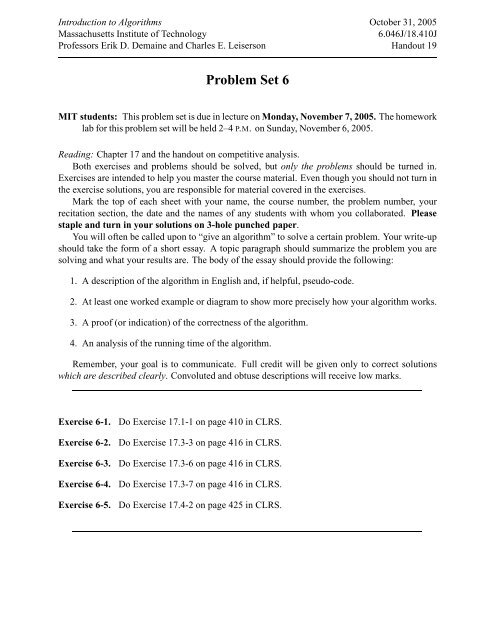
![18.03 Class 21, April 3 Fun with Fourier series [1] If f(t) is any decent ...](https://img.yumpu.com/51148985/1/190x245/1803-class-21-april-3-fun-with-fourier-series-1-if-ft-is-any-decent-.jpg?quality=85)

